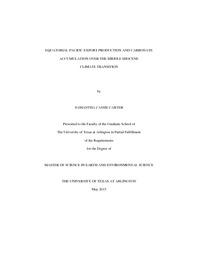
ATTENTION: The works hosted here are being migrated to a new repository that will consolidate resources, improve discoverability, and better show UTA's research impact on the global community. We will update authors as the migration progresses. Please see MavMatrix for more information.
Show simple item record
| dc.contributor.author | Carter, Samantha Cassie | en_US |
| dc.date.accessioned | 2015-07-31T22:10:19Z | |
| dc.date.available | 2015-07-31T22:10:19Z | |
| dc.date.submitted | January 2015 | en_US |
| dc.identifier.other | DISS-13175 | en_US |
| dc.identifier.uri | http://hdl.handle.net/10106/25114 | |
| dc.description.abstract | The Middle Miocene Climate Transition (MMCT) at ~13.8 million years ago (Ma) signifies the point when Earth made its final transition to the icehouse conditions of the Pleistocene. The MMCT is marked by the expansion of the Antarctic Ice Sheet (AIS) at ~13.8 Ma, and is characterized by an abrupt 1% increase in benthic foraminifer δ¹⁸O, of which 70% is interpreted to indicate expansion of the AIS (Shevenell et al., 2008). Centered on this cooling step is 'The Monterey Event' (Vincent and Berger, 1985), a globally recognized long positive carbon isotope excursion seen in benthic and planktonic foraminifera. Within this broad carbon isotope excursion are a series of carbon isotope maxima (CM) events that show high coherence with the long eccentricity cycle. The largest of these events, CM6, coincides with the major expansion of the AIS at ~13.8 Ma. A high resolution (<5 kyr) record of export production and carbonate accumulation in the eastern equatorial Pacific at IODP Site U1337 is presented spanning 14.1-13.5 Ma. This interval at the end of the MMCT appears to be a time of overall elevated export production of more than twice present day values, suggesting that the eastern equatorial Pacific may have been a sink for atmospheric pCO₂ in the middle Miocene. Carbonate accumulation shows a general increase over CM6, in agreement with other records from the Pacific and in contrast to records from the Atlantic Ocean, suggesting that changes in deep ocean circulation, such as an improvement in deep water ventilation, may have occurred allowing for more carbonate to be preserved at this site. Peaks in export production coincide with the beginning of AIS expansion as well as the beginning and end of CM6, supporting the notion that organic carbon export in the eastern equatorial Pacific played a crucial role in fostering global cooling by removing CO₂ from the atmosphere.. | en_US |
| dc.description.sponsorship | Griffith, Elizabeth M. | en_US |
| dc.language.iso | en | en_US |
| dc.publisher | Environmental & Earth Science | en_US |
| dc.title | Equatorial Pacific Export Production And Carbonate Accumulation Over The Middle Miocene Climate Transition | en_US |
| dc.type | M.S. | en_US |
| dc.contributor.committeeChair | Griffith, Elizabeth M. | en_US |
| dc.degree.department | Environmental & Earth Science | en_US |
| dc.degree.discipline | Environmental & Earth Science | en_US |
| dc.degree.grantor | University of Texas at Arlington | en_US |
| dc.degree.level | masters | en_US |
| dc.degree.name | M.S. | en_US |
Files in this item
- Name:
- Carter_uta_2502M_13175.pdf
- Size:
- 3.471Mb
- Format:
- PDF
This item appears in the following Collection(s)
Show simple item record


